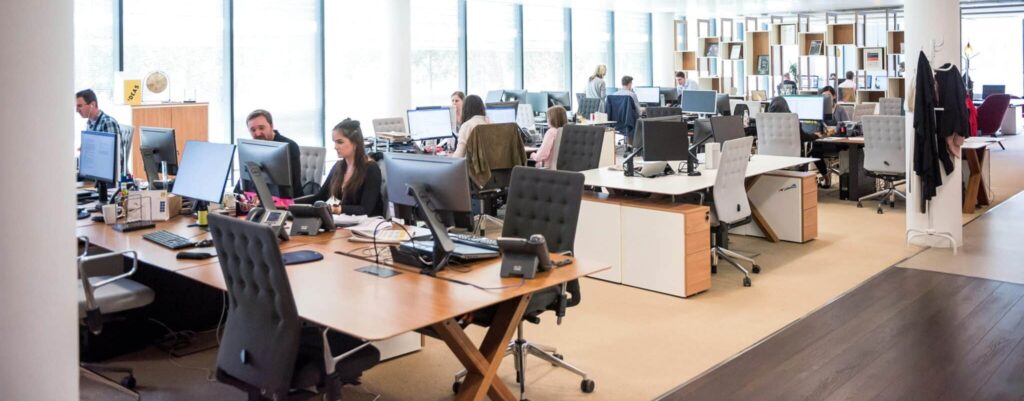The Rise of Collaboration Spaces

How we view the traditional office space has changed dramatically over the past several years – particularly post-pandemic. If you’ve been paying attention to trends in the business world, you’ve likely been made aware of the term “collaboration spaces.” As we transition toward more flexible working schedules and hybrid work, this term will continue to be more common.
In this article, we’ll discuss why collaborative workspaces are gaining popularity, the positive impact coworking spaces can have on your business, the different types of collaboration spaces, and where the future of work is headed.
What are collaboration spaces?
Collaboration spaces are, in the broadest sense, offices designed to promote employee productivity, improve communication between teams, and most importantly – increase collaboration! They’re designed to give employees more freedom to decide where and how they want to complete their work. By giving employees more autonomy, businesses are noticing increased levels of employee satisfaction.
Things you’ll notice in a collaboration space
- Open floor plans
- Greater sense of community
- Face-to-face interaction
- Unassigned seating
Things you won’t see in a collaboration space
- Structured floor plans
- Cubicles
- Feelings of isolation
- Assigned seating
Is a collaborative space the same thing as a meeting room?
While meeting rooms and collaboration spaces are both used to reach the common goal of creating thoughtful discussion, there are key differences in the way each space is designed.
You can probably picture it right now: a rectangular desk in the center of a large room, surrounded by chairs, with a monitor/whiteboard at the front of the room. This is the typical meeting or conference room. These settings can be great for weekly check-ins with your team but aren’t as conducive to brainstorming sessions.
A collaborative space, on the other hand, strays away from the norms of a traditional meeting room. These spaces are meant to spark engaging conversations and promote team collaboration. These spaces may have circular desks, stand-up desks, interactive drawing boards, outlets on every wall, etc. The goal of a collaboration space is to eliminate the structured, rigid format you’d see in a typical conference room. Everyone has the chance to bring new ideas to the table.
Those who adopt collaborative workspaces into their business model will likely see increased teamwork and spontaneous brainstorming sessions as a result of the informal setup of the space. Collaborative environments are meant to equip every employee with the tools and confidence to present new ideas to the team – no matter what their standing within the company.

What are the different types of collaboration spaces?
There are a few different types of collaborative workspaces that may be right for your business. This will depend entirely on the goals you’re trying to reach as a company. We’ll discuss three common types of collaboration spaces and why they may be the right model for your business.
Coworking spaces
In a coworking space, you’ll find workers from different companies sharing the same space. You may find yourself working alongside entrepreneurs, freelancers, or even small teams from another company. These spaces are unique in that they pit groups of people together from different professional backgrounds, allowing workers to share and exchange ideas with those whom they’d normally never engage with.
Coworking spaces are typically rented out by the individual or company, eliminating the need to commit to a long-term lease. This built-in flexibility is a large reason these spaces are gaining popularity. They are often sustained by a membership model.
Innovation Hubs
Innovation hubs are spaces where innovators, thinkers, inventors, and other professionals can meet to share ideas and collaborate. These spaces can be both virtual or physical, but will always share the common thread of being a melting pot for new ideas. If you have a million-dollar idea but are struggling with materializing it, innovation hubs can offer you the needed help.
Innovation hubs often provide helpful collaboration tools to those involved, including mentorship programs, funding opportunities & more. Whether you’re a remote worker or someone who likes to spend their days in an office, this shared workspace could benefit you.
Dedicated Collaboration
A dedicated collaboration space is often born out of a space in an office or home that isn’t being used. These spaces are designed to accommodate multiple team members at once, all of whom are working towards a common goal of creating new ideas. Dedicated collaboration spaces are often equipped with interactive whiteboards, video conferencing tools, and an ample amount of electrical outlets.
This office design is not the same as a typical meeting room. Meeting rooms can be a good place to escape the noise of the office if you’re trying to get some personal work done. Dedicated collaboration spaces are not designed to be used by one single person.
Why are collaboration spaces on the rise?
While it is true collaboration spaces have become increasingly more common since we have come out the other side of the COVID-19 pandemic, they were beginning to gain popularity even before then. The rise of coworking isn’t solely because employees prefer working in hybrid settings. Business owners and executives are also noticing significant benefits from switching over to a collaborative model. We’ll touch on three reasons why collaboration spaces have garnered the attention of countless CEOs in recent years.
They are better suited for hybrid workers
Different employees have different work styles. This is something that has become increasingly clear in recent years. Collaboration spaces are meant to accommodate all workers, regardless of their preferred work style. While a big benefit of collaboration spaces is the concept of face-to-face, spontaneous brainstorming sessions, they’re built to be able to manage hybrid work and remote work too.
The typical 9-5 job where you spend five days in the office is slowly getting phased out by the new hybrid model. According to a study done by Gallup, over half of U.S. remote-capable employees expect and prefer hybrid work. Using a collaboration space will equip you to handle remote work, hybrid work & in-person work in a seamless manner.
Business owners have more flexibility
The financial component of collaborative workspaces is a huge reason business owners want to build their business model around them. Before collaboration spaces were a known commodity, business owners typically had to lease out an office space for a set amount of time and were locked into that rate for the contract’s lifespan. In the event your company needed to downsize or reduce office space, you’d be locked into that entire office space for the duration of your lease.
Collaboration spaces remove the need for a long-term commitment to a plot of real estate. Not only does this give you financial flexibility, because it’s more of a “pay as you go” model, but it also gives you the flexibility to pack up and relocate your business practically whenever you want. These physical spaces especially benefit startups, who are typically already strapped for financial resources.
Promotes a healthier work environment
Good business owners are always looking for ways to promote a healthier work environment for their employees. Collaboration spaces can offer a significant boost to your company culture by putting more autonomy in the hands of the employee. CEOs who opt for collaborative workspaces will notice immediate increases in happiness levels and work output, which we’ll discuss next.
The positive impact of collaborative spaces
We’ve touched on some key reasons collaboration spaces are on the rise. But how can they directly benefit the overall flow of your day-to-day operations? We’ll discuss several major reasons collaboration spaces can increase output, improve employee happiness, and strengthen relationships between sectors.
Improved work-life balance
Collaboration spaces are built to accommodate every style of worker, allowing the employee to decide where and how they are most comfortable getting work done. Those who prefer staying active, interacting face-to-face, and getting their hands dirty may choose to come into the office more than someone who prefers the comfort of their home. Regardless, employees can better plan and coordinate non-work obligations knowing they aren’t required to be in an office daily.
Optimized space utilization
The archaic office setups with wasted space, dozens of bulky cubicles, and unused meeting rooms are slowly being eradicated from the professional workspace. Business owners find that their money is better spent on a personalized collaboration space, where they can maximize every inch of their office setup. Instead of committing to a lease or buying a plot of real estate, consider paying only for what you’ll use with a collaboration space.
Improved communication across teams
Collaboration spaces are an excellent way to inspire your entire team to share ideas, offer constructive criticism, and brainstorm. They’re designed so that everyone in the room is given an equal opportunity to present new ideas, whether you’re a new trainee or a seasoned project manager. Workstations aren’t specified and blurting out new ideas is encouraged. This all leads to a greater sense of community.
Sustainability
Thought leaders and business owners are focusing on sustainability more than ever before, constantly looking for ways to cut down their ecological footprint and make the most out of their given resources. By adopting collaborative workspaces into your business model, you can minimize your carbon footprint by sharing a common space with other organizations. Contrast this to the scenario where all organizations working in that shared space have their own office.
Collaboration spaces and the future of work
Now that you know why collaboration spaces are rising and how they can positively impact your business, it’s time to brace for what’s coming next.
It’s unlikely this trend will die down anytime soon. As the world’s next great generation of humans enters the workforce, hybrid work models and collaborative workspaces will soon become non-negotiables. Don’t put a limit on the talent you’re able to acquire just because you’re too stubborn or intimidated by the idea of a collaboration space. Hopefully, you now have all the tools you need to make an informed decision about the future of your office space!
Evolving your standard office space into a modern collaboration space will make you a more coveted destination and improve overall efficiency. Learn how OfficeSpace Software is changing the landscape of collaboration spaces with its groundbreaking analytics technology.



